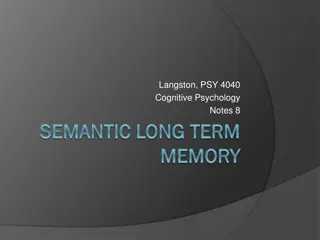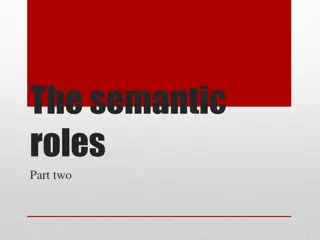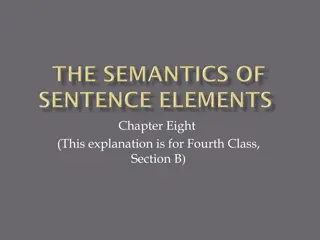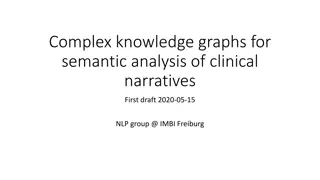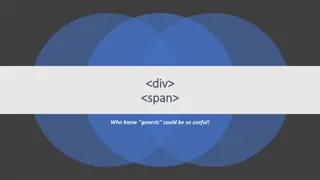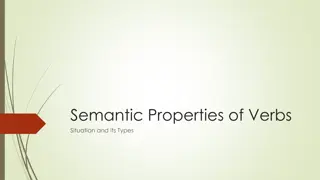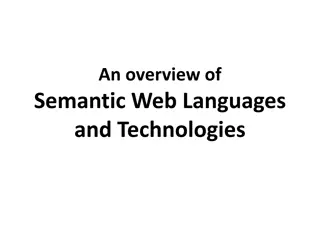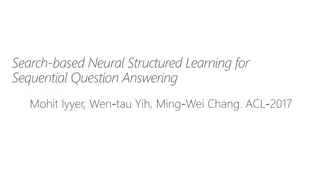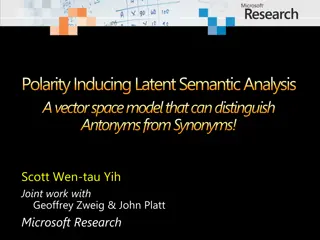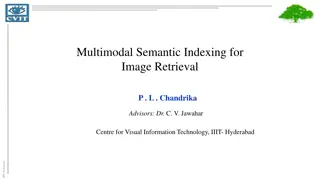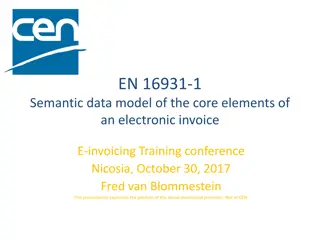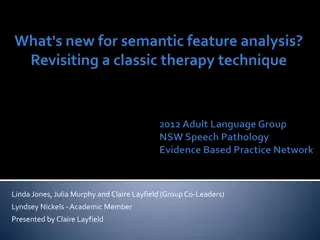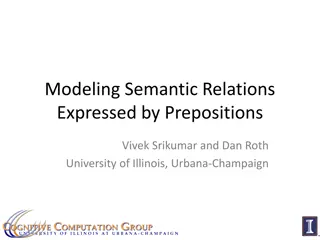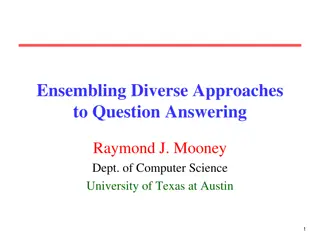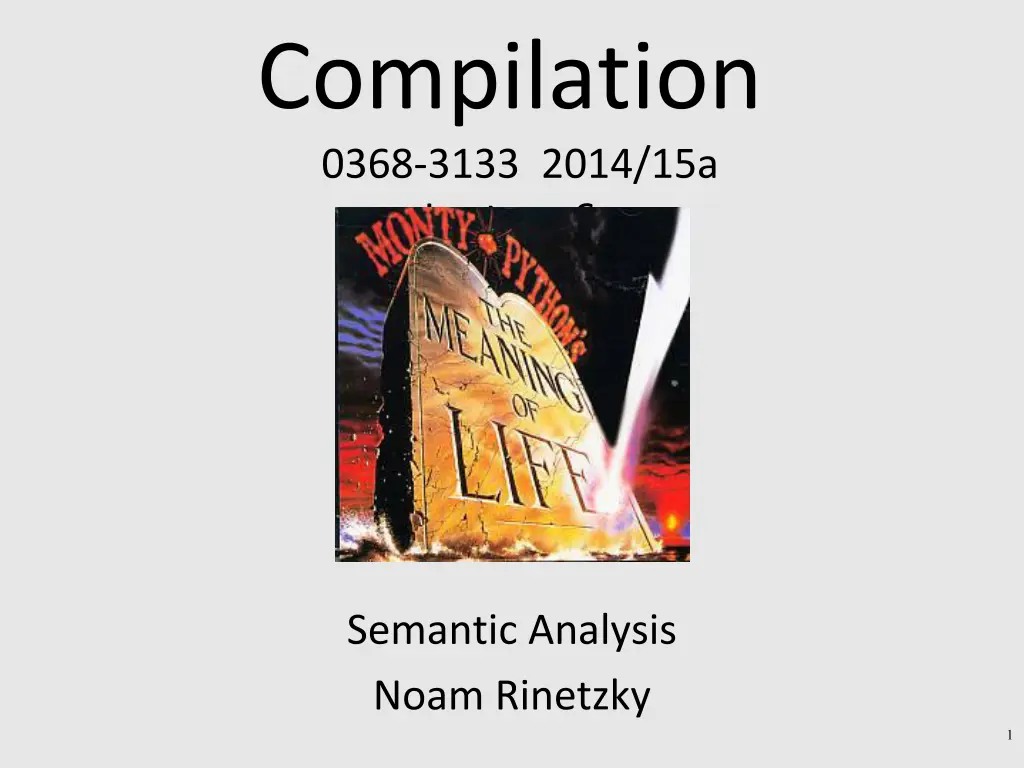
Semantic Analysis in Compiler Design
Explore the process of semantic analysis in compiler design, including lexical analysis, syntax analysis, and abstract syntax trees. Learn about the role of the AST, separation of concerns, and handling ambiguities in context-free grammars. Discover the importance of syntactic information and building ASTs during parsing.
Download Presentation

Please find below an Image/Link to download the presentation.
The content on the website is provided AS IS for your information and personal use only. It may not be sold, licensed, or shared on other websites without obtaining consent from the author. If you encounter any issues during the download, it is possible that the publisher has removed the file from their server.
You are allowed to download the files provided on this website for personal or commercial use, subject to the condition that they are used lawfully. All files are the property of their respective owners.
The content on the website is provided AS IS for your information and personal use only. It may not be sold, licensed, or shared on other websites without obtaining consent from the author.
E N D
Presentation Transcript
Compilation 0368-3133 2014/15a Lecture 6 Semantic Analysis Noam Rinetzky 1
You are here txt Process text input Lexical Analysis Syntax Analysis Semantic Analysis tokens characters AST Source text Annotated AST Code Intermediate code optimization Intermediate code generation Back End IR IR generation Symbolic Instructions exe Target code optimization Machine code generation Write executable output SI MI Executable code 2
Oops int x; xx = 0; int x, y; z = x + 1; Can the parser help? main() { break; } int x; print(x) 3
0 or 1 this is the question int x = 0; Can the parser help? p() { print(x) } q() { int x = 1; p() } 4
We want help Semantic (Context) analysis to the rescue Syntax Analysis Semantic Analysis AST 5
We want help Semantic (Context) analysis to the rescue Syntax Analysis Semantic Analysis AST 6
Abstract Syntax Tree AST is a simplification of the parse tree Can be built by traversing the parse tree E.g., using visitors Can be built directly during parsing Add an action to perform on each production rule Similarly to the way a parse tree is constructed 7
Abstract Syntax Tree The interface between the parser and the rest of the compiler Separation of concerns Reusable, modular and extensible The AST is defined by a context free grammar The grammar of the AST can be ambiguous! E E + E Is this a problem? Keep syntactic information Why? 8
What we want Potato potato; Carrot carrot; x = tomato + potato + carrot Lexical analyzer <id,tomato>,<PLUS>,<id,potato>,<PLUS>,<id,carrot>,EOF Parser AddExpr left right symbol kind type properties x var ? AddExpr left right tomato var ? potato var Potato LocationExpr id=tomato LocationExpr id=potato LocationExpr carrot var Carrot id=carrot tomato is undefined potato used before initialized Cannot add Potato and Carrot 9
Context Analysis Check properties contexts of in which constructs occur Properties that cannot be formulated via CFG Type checking Declare before use Identifying the same word w re-appearing wbw Initialization Properties that are hard to formulate via CFG break only appears inside a loop Processing of the AST 10
Context Analysis Identification Gather information about each named item in the program e.g., what is the declaration for each usage Context checking Type checking e.g., the condition in an if-statement is a Boolean 11
Identification month : integer RANGE [1..12]; month := 1; while (month <= 12) { print(month_name[month]); month : = month + 1; } 12
Identification month : integer RANGE [1..12]; month := 1; while (month <= 12) { print(month_name[month]); month : = month + 1; } Forward references? Languages that don t require declarations? 13
Symbol table month : integer RANGE [1..12]; month := 1; while (month <= 12) { print(month_name[month]); month : = month + 1; } name pos type month 1 RANGE[1..12] month_name A table containing information about identifiers in the program Single entry for each named item 14
Not so fast struct one_int { int i; } i; A struct field named i A struct variable named i main() { i.i = 42; int t = i.i; printf( %d ,t); } Assignment to the i field of struct i Reading the i field of struct i 15
Not so fast struct one_int { int i; } i; A struct field named i A struct variable named i main() { i.i = 42; int t = i.i; printf( %d ,t); { int i = 73; printf( %d ,i); } } Assignment to the i field of struct i Reading the i field of struct i int variable named i 16
Scopes Typically stack structured scopes Scope entry push new empty scope element Scope exit pop scope element and discard its content Identifier declaration identifier created inside top scope Identifier Lookup Search for identifier top-down in scope stack 17
Scope-structured symbol table so long // 3 P P and thanks x { int the=1; int fish=2; int thanks=3; { int x = 42; int all = 73; { } } } // 2 P P P x all // 1 P P thanks the fish 0 // P P P Scope stack 18
Scope and symbol table Scope x Identifier -> properties Expensive lookup A better solution hash table over identifiers 19
Hash-table based Symbol Table Id.info x name decl // 1 P 2 P thanks name decl // 0 P 2 P so name decl // 3 P 20
Scope Info Id.info( so ) Id.info( long ) // 3 Id.info( and ) Id.info( thanks ) Id.info( x ) // 2 Id.info( x ) Id.info( all ) // 1 Id.info( thanks ) Id.info( the ) Id.info( fish ) 0 // Scope stack 21 (now just pointers to the corresponding record in the symbol table)
Symbol table month : integer RANGE [1..12]; month := 1; while (month <= 12) { print(month_name[month]); month : = month + 1; } name pos type month 1 RANGE[1..12] month_name A table containing information about identifiers in the program Single entry for each named item 22
Semantic Checks Scope rules Use symbol table to check that Identifiers defined before used No multiple definition of same identifier Type checking Check that types in the program are consistent How? Why? 23
Types What is a type? Simplest answer: a set of values + allowed operations Integers, real numbers, booleans, Why do we care? Code generation: $1 := $1 + $2 Safety Guarantee that certain errors cannot occur at runtime Abstraction Hide implementation details Documentation Optimization 24
Type System (textbook definition) A type system is a tractable syntactic method for proving the absence of certain program behaviors by classifying phrases according to the kinds of values they compute -- Types and Programming Languages by Benjamin C. Pierce 25
Type System A type system of a programming language is a way to define how good program behave Good programs = well-typed programs Bad programs = not well typed Type checking Static typing most checking at compile time Dynamic typing most checking at runtime Type inference Automatically infer types for a program (or show that there is no valid typing) 26
Static typing vs. dynamic typing Static type checking is conservative Any program that is determined to be well-typed is free from certain kinds of errors May reject programs that cannot be statically determined as well typed Why? Dynamic type checking May accept more programs as valid (runtime info) Errors not caught at compile time Runtime cost Why? 27
Type Checking Type rules specify which types can be combined with certain operator Assignment of expression to variable Formal and actual parameters of a method call Examples int string string string 42 + the answer drive + drink string ERROR 28
Type Checking Rules Specify for each operator Types of operands Type of result Basic Types Building blocks for the type system (type rules) e.g., int, boolean, (sometimes) string Type Expressions Array types Function types Record types / Classes 29
Typing Rules If E1 has type int and E2 has type int, then E1 + E2 has type int E1 : int E2 : int E1 + E2 : int 30
More Typing Rules (examples) true : boolean false : boolean int-literal : int string-literal : string E1 : int E2 : int op { +, -, /, *, %} E1 op E2 : int E1 : int E2 : int rop { <=,<, >, >=} E1 rop E2 : boolean E1 : T E2 : T rop { ==,!=} E1 rop E2 : boolean 31
And Even More Typing Rules E1 : boolean E2 : boolean lop { &&,|| } E1 lop E2 : boolean E1 : boolean E1 : int - E1 : int ! E1 : boolean E1 : T[] E1 : T[] E2 : int E1 : int E1.length : int E1[E2] : T new T[E1] : T[] 32
Type Checking Traverse AST and assign types for AST nodes Use typing rules to compute node types Alternative: type-check during parsing More complicated alternative But naturally also more efficient 33
Example E1 : boolean E2 : boolean E1 lop E2 : boolean BinopExpr op=AND : boolean lop { &&,|| } E1 : boolean !E1 : boolean : boolean : boolean BinopExpr op=GT UnopExpr op=NEG E1 : int E2 : int E1 rop E2 : boolean rop { <=,<, >, >=} intLiteral val=45 intLiteral val=32 boolLiteral val=false : int : int false : boolean : boolean int-literal : int 45 > 32 && !false 34
Type Declarations So far, we ignored the fact that types can also be declared TYPE Int_Array = ARRAY [Integer 1..42] OF Integer; (explicitly) Var a : ARRAY [Integer 1..42] OF Real; (anonymously) 35
Type Declarations Var a : ARRAY [Integer 1..42] OF Real; TYPE #type01_in_line_73 = ARRAY [Integer 1..42] OF Real; Var a : #type01_in_line_73; 36
Forward References TYPE Ptr_List_Entry = POINTER TO List_Entry; TYPE List_Entry = RECORD Element : Integer; Next : Ptr_List_Entry; END RECORD; Forward references must be resolved A forward references added to the symbol table as forward reference, and later updated when type declaration is met At the end of scope, must check that all forward references have been resolved Check must be added for circularity 37
Type Table All types in a compilation unit are collected in a type table For each type, its table entry contains: Type constructor: basic, record, array, pointer, Size and alignment requirements to be used later in code generation Types of components (if applicable) e.g., types of record fields 38
Type Equivalence: Name Equivalence Type t1 = ARRAY[Integer] OF Integer; Type t2 = ARRAY[Integer] OF Integer; t1 not (name) equivalence to t2 Type t3 = ARRAY[Integer] OF Integer; Type t4 = t3 t3 equivalent to t4 39
Type Equivalence: Structural Equivalence Type t5 = RECORD c: Integer; p: POINTER TO t5; END RECORD; Type t6 = RECORD c: Integer; p: POINTER TO t6; END RECORD; Type t7 = RECORD c: Integer; p: POINTER TO RECORD c: Integer; p: POINTER to t5; END RECORD; END RECORD; t5, t6, t7 are all (structurally) equivalent 40
In practice Almost all modern languages use name equivalence 41
Coercions If we expect a value of type T1 at some point in the program, and find a value of type T2, is that acceptable? float x = 3.141; int y = x; 42
l-values and r-values dst := src What is dst? What is src? dst is a memory location where the value should be stored src is a value location on the left of the assignment called an l-value value on the right of the assignment is called an r-value 43
l-values and r-values (example) x:= y + 1 73 17 0x42 0x42 x x 16 16 0x47 0x47 y y 44
l-values and r-values expected lvalue rvalue found lvalue - rvalue error deref - 45
So far Static correctness checking Identification Type checking Identification matches applied occurrences of identifier to its defining occurrence The symbol table maintains this information Type checking checks which type combinations are legal Each node in the AST of an expression represents either an l-value (location) or an r-value (value) 46
How does this magic happen? We probably need to go over the AST? how does this relate to the clean formalism of the parser? 47
Syntax Directed Translation Semantic attributes Attributes attached to grammar symbols Semantic actions How to update the attributes Attribute grammars 48
Attribute grammars Attributes Every grammar symbol has attached attributes Example: Expr.type Semantic actions Every production rule can define how to assign values to attributes Example: Expr Expr + Term Expr.type = Expr1.type when (Expr1.type == Term.type) Error otherwise 49
Indexed symbols Add indexes to distinguish repeated grammar symbols Does not affect grammar Used in semantic actions Expr Expr + Term Becomes Expr Expr1 + Term 50


